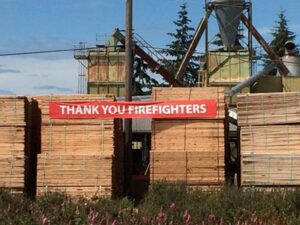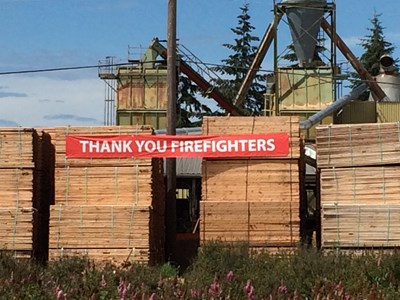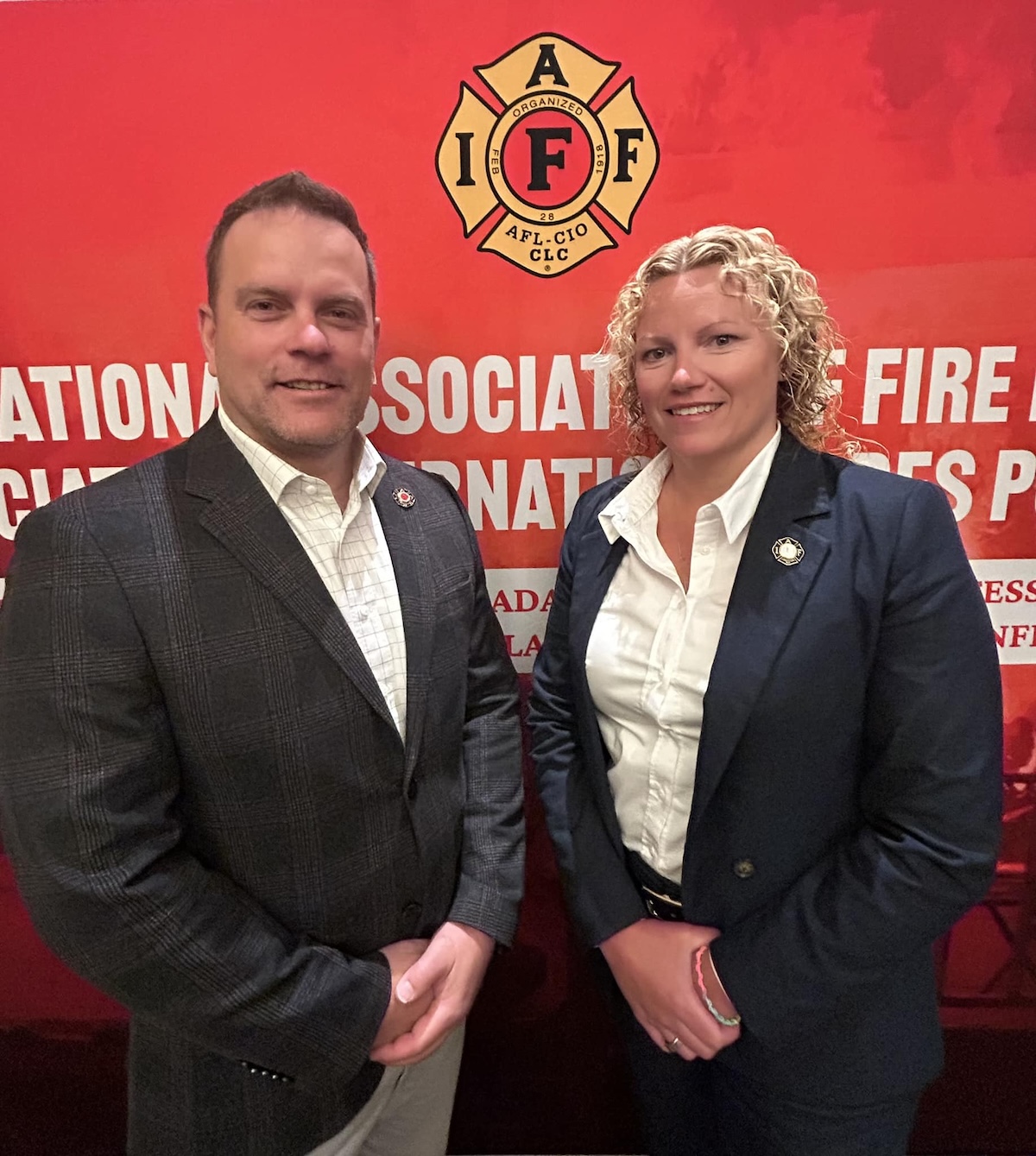 Though it burned for three days, it was in the critical first few hours of a recent peat bog fire that Delta, BC Local 1763 won its biggest battle, saving an industrial park from destruction and preventing what could have been a major economic disaster for the region.
Though it burned for three days, it was in the critical first few hours of a recent peat bog fire that Delta, BC Local 1763 won its biggest battle, saving an industrial park from destruction and preventing what could have been a major economic disaster for the region.
The fast, effective response – made possible by the fact that the Corporation of Delta chooses to provide adequate frontline fire protection resources that are appropriate for the community’s risks – likely saved millions in property loss and tax revenues and thousands of jobs.
The bog fire, which started July 3, quickly jumped a highway where it threatened the Tilbury Industrial Park, which is home to hundreds of industrial and commercial facilities, including a lumber yard, chemical companies and other high-hazard uses.
If the densely-packed lumber in the lumber yard had caught fire, the ensuing inferno would likely have spread quickly to other businesses. But the Delta fire fighters on duty who leaped into action, positioning themselves strategically between the fire line and the industrial park attacked hot spots and the leading edge of the fire, protecting the lumber yard with an aerial water tower truck.
“We stopped this fire where we did only because Delta has a staffed, full-time fire department that has invested wisely in apparatus, equipment and training,” says Mike McMillan, president of Delta Local 1763. “Every year, all our suppression staff re-certify in wildland fire fighting and train on all our equipment, including a wildland fire fighting apparatus, which proved itself at this fire.”
The industrial park has a property assessment value of $2 billion and generates $22 million in taxes to the city every year, which would also have been lost if the park had been consumed by fire.
The city’s level of preparedness not only saved residents and businesses from major impacts from the bog fire, fire fighters simultaneously responded to an unrelated structure fire in another area of the city, responded to a highway rollover and used their enhanced medical skills to provide immediate medical attention to a fellow fire fighter who suffered a medical emergency during the response.
While all professional fire fighters across Canada provide some level of medical response, Delta fire fighters, who often arrive on scene before ambulances, last year began offering enhanced medical response, including pain relief, IV maintenance and symptom relief. The enhanced medical response is a value-added service that takes advantage of existing personnel and vehicles to improve patient care in a cost-effective manner.
As the bog fire continued, the city received assistance from other sources, including the British Columbia Wildfire Service and Metro Vancouver Parks personnel, who were crucial in helping to finally control and extinguish the remaining fire. As Delta fire fighters were tasked to the initial attack and responding to other emergencies within the community, Delta fire halls were backfilled by crews from New Westminster and Richmond to maintain a level of protection for other emergencies. In addition, Surrey was on stand-by, ready to assist if necessary. In all, the response was a case study in proper emergency preparedness, as evidenced by the fact there were no casualties from the fire, and loss and disruption were kept to an absolute minimum.
Similar to the recent wildfire that ravaged Fort McMurray, the Delta Burns Bog fire proves that adequate frontline emergency response resources – such as personnel, vehicles, equipment and training – can be a major determining factor in the outcome of a large-scale disaster.
“The media often reports fire loss, but rarely report what was saved,” says Scott Marks, a retired Toronto fire fighter who now heads the International Association of Fire Fighters (IAFF) Canadian Operations. “These fires prove once again that fire protection is an investment that pays dividends in the form of lives and property saved and reduced economic impact when jobs are saved.” Investments in fire protection also pay off in the form of generally lower commercial and residential insurance rates.
On the flip side, cities that understaff and under-resource their fire departments put their residents, property and their infrastructure at unnecessary risk, while any tax savings are likely more than eaten up by higher residential and commercial insurance premiums.
For example, in October, the city of Sault Ste. Marie, Ontario, slashed its frontline fire fighting resources by almost 25 per cent, even though the average household only pays 66 cents a day for fire protection. Now, the city of 75,000 people has only 13 fire fighters on duty at a given time, which, according to accepted public safety standards such as National Fire Protection Association (NFPA) 1710, is not enough to safely and effectively respond to a residential fire, let alone to simultaneous emergencies or fires in high-occupancy or high-risk settings, such as nursing homes, schools, strip malls, industrial parks and other commercial facilities.
“Sault Ste. Marie is extremely vulnerable right now due to a lack of frontline resources, Marks says. “The capacity to respond to a serious disaster like this is extremely limited.”
Full-time fire fighters are skilled, certified and highly-trained professionals who on duty in cities across Canada 24/7/365, ready to respond to virtually any emergency in minutes, all for less than $1 per day to the typical household (based on average property assessments). Today’s fire departments provide services that include not only fire fighting, but emergency medical response, as well as water/ice rescue, haz-mat response, vehicular extrication and more. When a major disaster strikes, cities with adequate frontline resources are better positioned to get a jump on their response and mitigate the impacts from the earliest stages.
This reality flies in the face of a report issued by the Fraser Institute last year that argued unsuccessfully that Canadian municipalities employ too many fire fighters. The report used flawed data and overestimated the number of municipal full-time fire fighters in Canada, ignored the fact that fire fighters do more than fight fires, and ignored the fact that fires burn much hotter and faster than they used to. The Fraser report was subsequently cited in some newspaper opinion pieces that built on its flawed data to reach flawed conclusions about fire fighters and what they really do.
“We didn’t see any newspaper columnists arguing that there were too many fire fighters during the Fort McMurray crisis or the Delta bog fire,” Marks points out. “That’s because people ultimately realize that having effective fire protection is like insurance, you may not need it every day, but when you do, you’re extremely glad it’s there.”
The media recently reported that the wildfire that ravaged Fort McMurray was the most expensive disaster in Canadian history, with a cost of $3.58 billion in damage. But few media reported that fire fighters, who saved almost 90 per cent of the city through their heroics, potentially averted $30 billion in losses and untold levels of loss and grief for the vast majority of homeowners whose homes and possessions were saved.
Meanwhile in Delta, Leslie Forest Products, one of the businesses saved by fire fighters during the bog fire, shared its gratitude with citizens by hanging a large “THANK YOU FIRE FIGHTERS” banner on a large pile of lumber in its yard – lumber that will be sold and used because it’s in perfect condition and not a pile of charred embers and ash.



